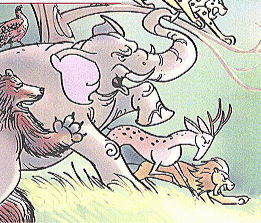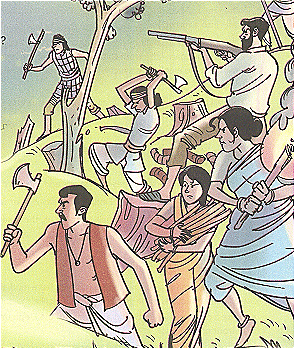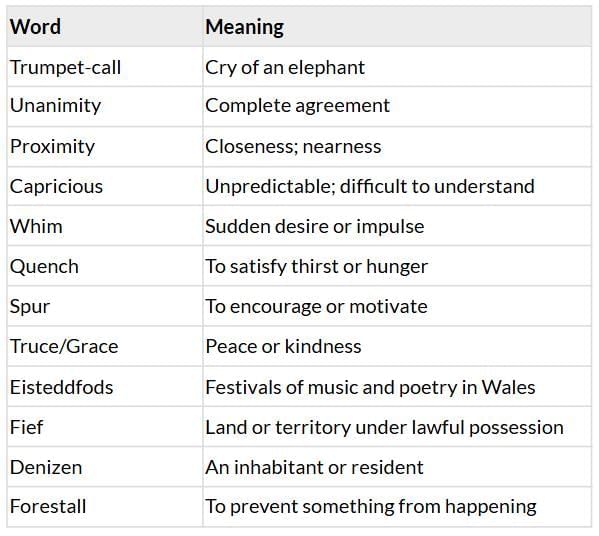Summary: The Elephant and the Tragopan | Gul Mohar Class 8: Book Solutions, Summaries & Worksheets PDF Download
| Table of contents |

|
| About the Author |

|
| Detailed Summary (Stanza by Stanza) |

|
| Moral / Message |

|
| Vocabulary Table |

|
About the Author
Vikram Seth (b. 1952) is a well-known Indian poet and novelist. His works include A Suitable Boy, The Golden Gate, and An Equal Music. He is also admired for his poetry collections like Mappings and Beastly Tales. His writings often explore human nature, relationships, and our connection with the environment, blending humour, wisdom, and moral lessons.
Detailed Summary (Stanza by Stanza)
Stanza 1
They talked for hours, and at the close
At last the elephant arose,
And with a modest trumpet-call
Drew the attention of them all:
"O Beasts of Bingle gathered round,
Though in our search for common ground
I would not dream of unanimity
I hope our views may reach proximity.
I speak to you as one whose clan
Has served and therefore studied man.
He is a creature mild and vicious,
Practical-minded and capricious,
Loving and brutal, sane and mad,
The good as puzzling as the bad.
The sticky centre of this mess
Is an uneasy selfishness."
Explanation:
The elephant addresses the animals gathered in Bingle. He admits they may not all agree but hopes they can share common views. Based on his long experience with humans, he describes man as a puzzling mixture of good and bad, kind and cruel, predictable and unpredictable. At the core, man is selfish.
[Intext Question]
Stanza 2
He rips our flesh and tears our skin
For cloth without, for food within.
The leopard's spots are his to wear.
Our ivory unknots his hair.
The tragopan falls to his gun.
He shoots the flying fox for fun.
The black bear dances to his whim.
My own tame cousins slave for him.
Explanation:
The elephant lists the many ways humans exploit animals. Leopards are hunted for their skins, elephants for ivory, tragopans and flying foxes are killed for sport, and bears are forced to perform tricks. Even elephants are enslaved to serve humans.
Stanza 3
Yet we who give him work and food
Have never earned his gratitude.
He grasps our substance as of right
To quench and spur his appetite,
Nor will he grant us truce or grace
To rest secure in any place.
Sometimes he worships us as Gods
Or sings of us at Eisteddfods,
Or fashions fables, myths and stories
To celebrate our deeds and glories.
And yet, despite this fertile fuss,
When has he truly cared for us?
Explanation:
Although animals serve man and provide him with food, they never receive gratitude. Humans take from nature as if it belongs only to them, without offering peace or security in return. At times, humans worship animals or celebrate them in festivals, stories, and songs, but in reality, they never truly care about their well-being.

Stanza 4
Or seed or blade or grain of sand
Is destined for his mouth or hand.
If he is thirsty, we must thirst—
For of all creatures, man comes first.
If he needs room, then we must fly;
And if he hungers, we must die.
Explanation:
Here the elephant highlights man’s selfishness even more. Every resource, whether food, land, or water, is claimed by humans. Animals must suffer thirst, lose their homes, or even die so that humans can satisfy their needs.
Stanza 5
Think what will happen, when his scheme
To tame our valley and our stream
Begins to thrust its way across
These gentle slopes of fern and moss
With axe, explosive and machine.
Since rhododendron logs burn green
They'll all be chopped for firewood—
Or logged and smuggled out for good.
As every bird and mammal knows,
When the road comes, the forest goes.
And let me say this to the trout—
The bamboo will be slashed, no doubt,
And what the tragopan and I
Delight to eat, will burn and die.
But what will happen to your stream?
Before the reservoir, your dream
Of endless space, can come about,
The soot and filth will snuff you out.
Explanation:
The elephant warns of the dangers of human development. Forests and rivers will be destroyed by roads, machines, and logging. Trees will be cut, food will disappear, and rivers will become polluted. Even fish like trout will lose their clean streams. All animals will lose their homes and food sources.

Stanza 6
What tolls for us is your own bell.
And similarly let me tell
The leopards who may fancy here
A day of fleeing deer—your happy, passing slaughter,
You too will have to flee from water.
You will all be homeless, like us all.
It is this fate we must forestall.
So let me say to every single
Endangered denizen of Bingle:
We must unite in fur and feather—
For we will live or die together."
Explanation:
The elephant ends by warning that no animal is safe. Leopards, deer, fish, birds, and elephants will all lose their homes due to man’s greed. He urges all animals to unite, because only by standing together can they hope to survive. Their survival depends on collective action.
Moral / Message
The poem is a strong warning about human greed and environmental destruction. Vikram Seth shows how humans exploit animals, forests, and rivers without gratitude or care. The message is clear: nature is shared by all creatures, and man’s selfishness will destroy not only animals but also his own future. The poem urges respect for nature, unity among all beings, and the urgent need to stop environmental destruction.
Vocabulary Table

|
32 videos|62 docs|17 tests
|
FAQs on Summary: The Elephant and the Tragopan - Gul Mohar Class 8: Book Solutions, Summaries & Worksheets
| 1. What is the main theme of "The Elephant and the Tragopan"? |  |
| 2. Who are the primary characters in the story, and what do they represent? |  |
| 3. What moral lesson can be derived from the story? |  |
| 4. How does the author use imagery to enhance the story? |  |
| 5. What can readers learn about the relationship between humans and wildlife from this article? |  |















